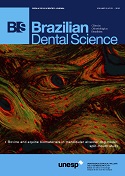Correlation between thumb length on handgrip strength, hand dexterity and musculoskeletal problem among dental professional
DOI:
https://doi.org/10.14295/bds.2016.v19i3.1171Abstract
Objective: The key factor for potency of the teeth is their muscular strength. The dominant hand plays an important role in most of the daily muscular activities involving dental procedure. There are many factors, which may affect the grip strength, and very few studies especially in India have shown their correlation with grip strength. Work related musculoskeletal disorders (WRMSD) are an important occupational health problem affecting dental practitioners. This study assessed the prevalence of WRMSD in dental interns in relation to the thumb length and hand grip strength. Material and Methods: Thumb length template, jammer dynamometer, nine-hole peg board, and RULA assessment. Methods: Thumb length was measured by thumb length template. Grip strength was measured by jammer dynamometer, unilateral hand finger dexterity was measured by nine-hole pegboard, and work related musculoskeletal disorder was assessed by RULA. Results: Thumb length was positively correlated with grip strength and work related musculoskeletal disorder. Thumb length was negatively correlated with unilateral hand finger dexterity among dental professionals. Conclusion: Thumb length is a better predictor for measuring hand grip strength and work related musculoskeletal disorder, than unilateral hand finger dexterity.
Keywords
Dental professional; Hand grip strength; Thumb length; Unilateral hand finger dexterity; Work related musculoskeletal disorder.
Downloads
Downloads
Published
How to Cite
Issue
Section
License
Brazilian Dental Science uses the Creative Commons (CC-BY 4.0) license, thus preserving the integrity of articles in an open access environment. The journal allows the author to retain publishing rights without restrictions.
=================




























